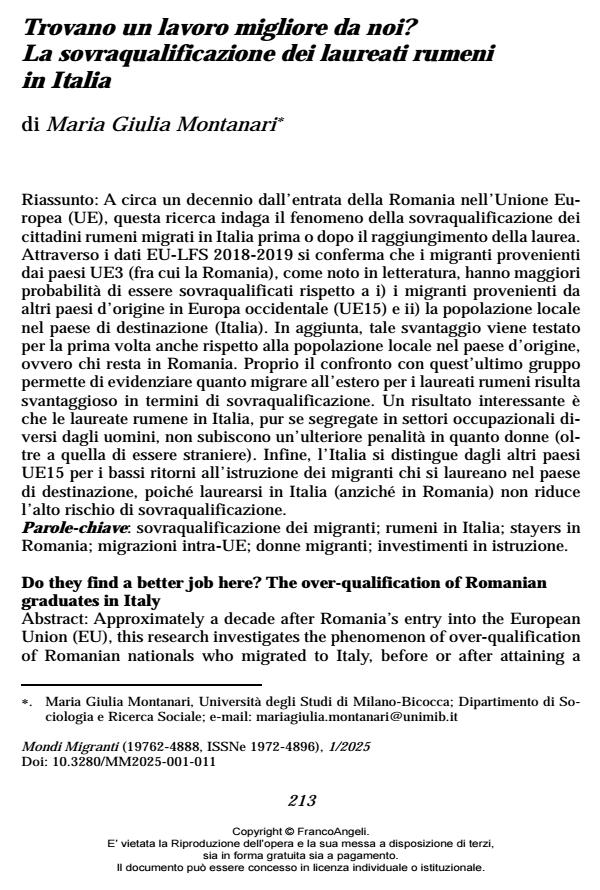Trovano un lavoro migliore da noi? La sovraqualificazione dei laureati rumeni in Italia
Titolo Rivista MONDI MIGRANTI
Autori/Curatori Maria Giulia Montanari
Anno di pubblicazione 2025 Fascicolo 2025/1
Lingua Italiano Numero pagine 31 P. 213-243 Dimensione file 187 KB
DOI 10.3280/MM2025-001011
Il DOI è il codice a barre della proprietà intellettuale: per saperne di più
clicca qui
Qui sotto puoi vedere in anteprima la prima pagina di questo articolo.
Se questo articolo ti interessa, lo puoi acquistare (e scaricare in formato pdf) seguendo le facili indicazioni per acquistare il download credit. Acquista Download Credits per scaricare questo Articolo in formato PDF

FrancoAngeli è membro della Publishers International Linking Association, Inc (PILA)associazione indipendente e non profit per facilitare (attraverso i servizi tecnologici implementati da CrossRef.org) l’accesso degli studiosi ai contenuti digitali nelle pubblicazioni professionali e scientifiche
A circa un decennio dall’entrata della Romania nell’Unione Europea (UE), questa ricerca indaga il fenomeno della sovraqualificazione dei cittadini rumeni migrati in Italia prima o dopo il raggiungimento della laurea. Attraverso i dati EU-LFS 2018-2019 si conferma che i migranti provenienti dai paesi UE3 (fra cui la Romania), come noto in letteratura, hanno maggiori probabilità di essere sovraqualificati rispetto a i) i migranti provenienti da altri paesi d’origine in Europa occidentale (UE15) e ii) la popolazione locale nel paese di destinazione (Italia). In aggiunta, tale svantaggio viene testato per la prima volta anche rispetto alla popolazione locale nel paese d’origine, ovvero chi resta in Romania. Proprio il confronto con quest’ultimo gruppo permette di evidenziare quanto migrare all’estero per i laureati rumeni risulta svantaggioso in termini di sovraqualificazione. Un risultato interessante è che le laureate rumene in Italia, pur se segregate in settori occupazionali diversi dagli uomini, non subiscono un’ulteriore penalità in quanto donne (oltre a quella di essere straniere). Infine, l’Italia si distingue dagli altri paesi UE15 per i bassi ritorni all’istruzione dei migranti chi si laureano nel paese di destinazione, poiché laurearsi in Italia (anziché in Romania) non riduce l’alto rischio di sovraqualificazione.
Parole chiave:sovraqualificazione dei migranti; rumeni in Italia; stayers in Romania; migrazioni intra-UE; donne migranti; investimenti in istruzione.
Maria Giulia Montanari, Trovano un lavoro migliore da noi? La sovraqualificazione dei laureati rumeni in Italia in "MONDI MIGRANTI" 1/2025, pp 213-243, DOI: 10.3280/MM2025-001011